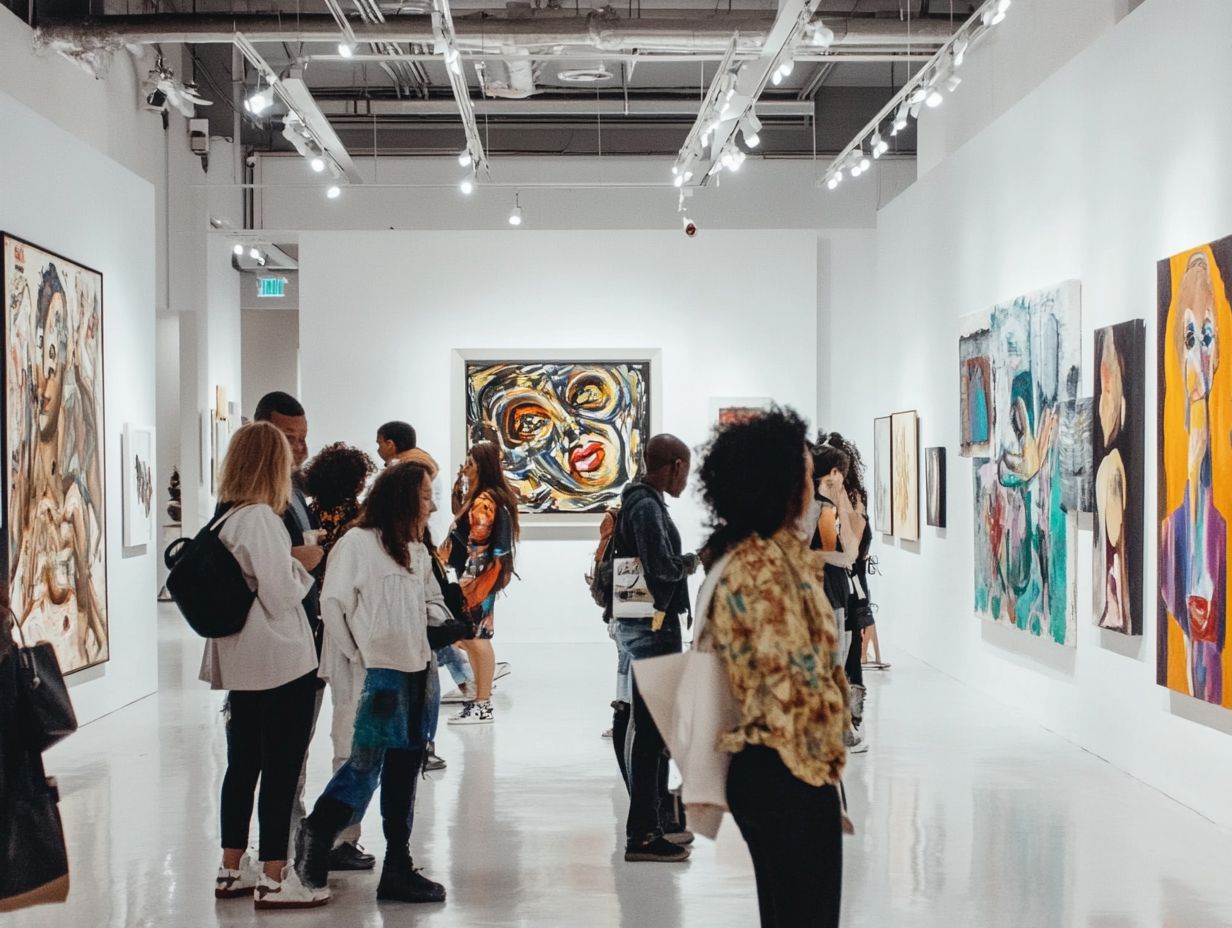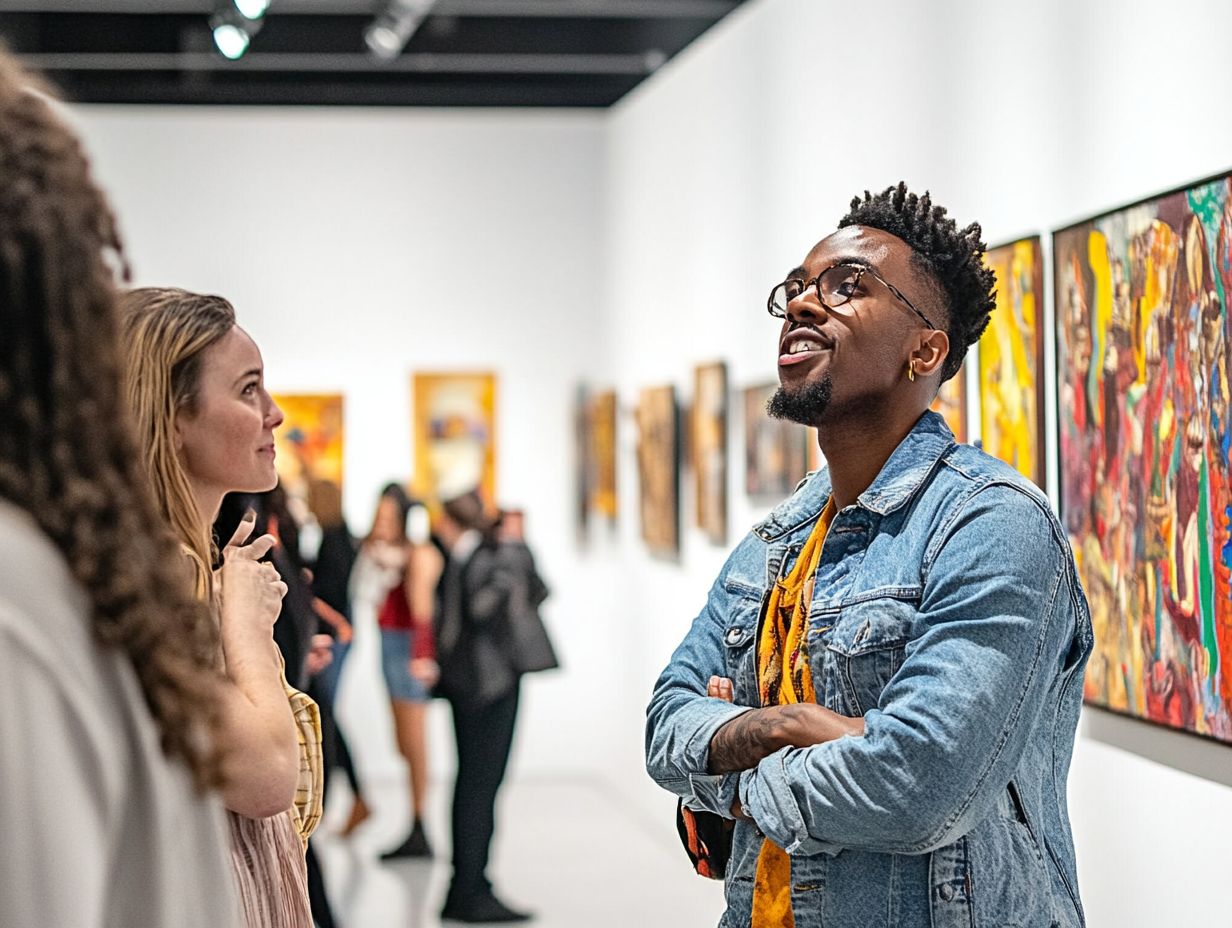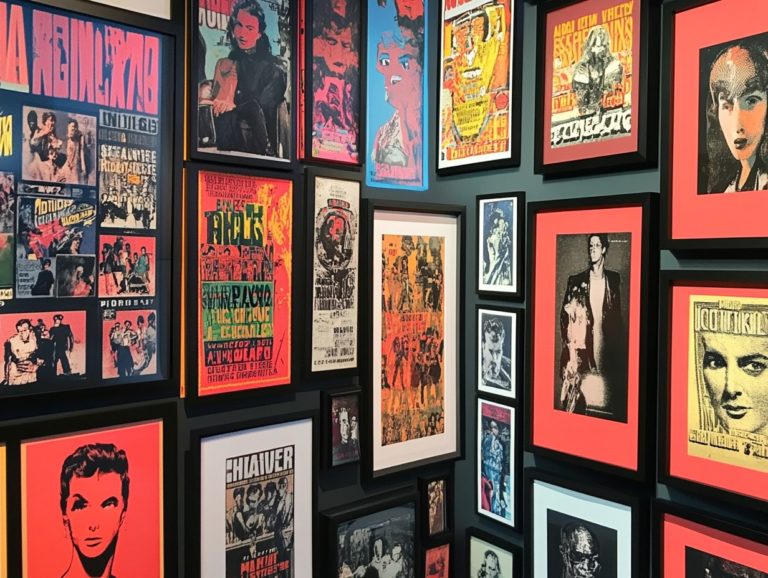5 Famous Art Collectors and Their Collections
Art collecting transcends mere hobby; it is a fervent passion that shapes cultural landscapes and inspires generations.
This exploration highlights five influential art collectors Peggy Guggenheim, Isabella Stewart Gardner, Albert C. Barnes, Gertrude Stein, and Charles Saatchi each possessing a unique collection that has indelibly marked the art world.
Delve into how they acquired their treasures, the challenges they navigated, and what makes their collections genuinely extraordinary.
Uncover the legacies of these remarkable individuals and their profound impact on the realm of art.
Contents
- Must-Know Insights on Iconic Art Collectors:
- 1. Peggy Guggenheim and the Peggy Guggenheim Collection
- 2. Isabella Stewart Gardner and the Isabella Stewart Gardner Museum
- 3. Albert C. Barnes and the Barnes Foundation
- 4. Gertrude Stein and the Gertrude Stein Collection
- 5. Charles Saatchi and the Saatchi Gallery
- How Did These Art Collectors Acquire Their Collections?
- Frequently Asked Questions
- Who are 5 famous art collectors?
- What are some famous collections owned by these art collectors?
- How did Peggy Guggenheim acquire her art collection?
- What type of art did Samuel Kress focus on collecting?
- What is unique about Gertrude Vanderbilt Whitney’s collection?
- How did Joseph Hirshhorn’s art collection become a museum?
Must-Know Insights on Iconic Art Collectors:

Peggy Guggenheim’s collection showcases innovative and modern art, including works by Picasso and Pollock, making it a must-see for art enthusiasts.
Isabella Stewart Gardner’s museum features a diverse range of artworks from different cultures and time periods, reflecting her passion for collecting.
The Barnes Foundation’s collection is known for its unique arrangement of artworks, inspired by Albert C. Barnes’s unconventional approach to art collecting.
1. Peggy Guggenheim and the Peggy Guggenheim Collection
Peggy Guggenheim stands as a pivotal figure in the art world. She made remarkable contributions to the modern art scene through her extraordinary collection of contemporary artists and European masterpieces.
She transformed the landscape of art institutions on a global scale. Your appreciation for her passion for collecting reveals how she nurtured renowned artists and reshaped the dynamics of art patronage, securing her legacy in both American and European art history.
Born into a wealthy American family in 1898, she emerged as a vibrant force in the 20th-century art movement. By actively supporting innovative visionaries like Jackson Pollock and Marcel Duchamp, she became a key player in the artistic revolution of her time.
Her extensive collection is a breathtaking journey through modern art! It is marked by works from surrealists and abstract expressionists, showcasing not just individual talent but also the evolution of modern artistic thought.
Guggenheim s keen eye made her one of the first to present these groundbreaking artists. By hosting exhibitions that captured the attention of critics and collectors alike, she solidified her role in redefining art accessibility.
Her opening of the Venetian palazzo as a museum ensures that future generations can appreciate the innovative spirit that permeates contemporary art today.
2. Isabella Stewart Gardner and the Isabella Stewart Gardner Museum
Isabella Stewart Gardner, a remarkable art collector, greatly impacted Boston’s culture and beyond with her opulent collection housed in the Isabella Stewart Gardner Museum. This museum is a must-visit treasure trove celebrated for its distinctive architectural style and rich historical art pieces.
Driven by an unwavering passion for culture, her vision created a museum that stands as both a sanctuary for art enthusiasts and a tribute to the artists whose works she cherished.
Within this extraordinary collection, you’ll discover masterpieces by luminaries such as Titian, Rembrandt, and Vermeer. Each piece unfolds a narrative that enriches the museum’s artistic tapestry.
This institution preserves Gardner’s cultural legacy and plays a vital role in shaping the aspirations of contemporary artists, nurturing a deep appreciation for diverse artistic expressions within the community.
3. Albert C. Barnes and the Barnes Foundation
Albert C. Barnes stands as a pivotal figure in the realm of art education and appreciation. He established the Barnes Foundation to showcase his extraordinary collection of modern masterpieces while fundamentally transforming how art is perceived and taught.
His philosophy was rooted in the belief that art should be accessible and relevant to everyone, not merely the elite. By arranging artworks in a way that encourages personal connections, he tore down the traditional barriers that have long hindered the understanding of art.
This distinctive approach to display challenged conventional art criticism and fostered a more intimate dialogue between you and the pieces. The foundation s innovative educational programs set a high standard for art institutions everywhere.
They highlight the vital role art plays in community life and serve as a model for inspiring future generations to engage with art on a deeper level.
4. Gertrude Stein and the Gertrude Stein Collection

Gertrude Stein was a key person in the avant-garde movement. She curated an extraordinary collection featuring renowned artworks and modern masterpieces, spotlighting artists who redefined artistic expression in her era.
Her influence deepens when you consider her relationships with luminaries like Pablo Picasso and Henri Matisse. Stein’s salon became a vibrant hub for innovative thinkers, shaping the future of contemporary art.
Her literary efforts, especially the groundbreaking piece ‘Three Lives,’ echoed her artistic vision and blurred the lines between literature and painting. This fusion created a powerful dialogue within the artistic community.
Through these intersections, she not only enhanced her collection s significance but also played a crucial role in championing the experimental approaches that defined much of the 20th century’s art scene.
5. Charles Saatchi and the Saatchi Gallery
Charles Saatchi has transformed the contemporary art scene through the Saatchi Gallery. He champions artistic contributions and provides a prestigious platform for both emerging and established artists to showcase their work.
His vision goes beyond hosting exhibitions. It reflects a deep commitment to redefining how we view and engage with contemporary art. Saatchi s influence resonates throughout the art market, elevating artists’ profiles and sparking public interest in their creations.
By curating groundbreaking exhibitions that challenge societal norms, he paves the way for many artists to gain significant acclaim.
Today, the gallery buzzes with energy, becoming a must-visit for art lovers and collectors!
How Did These Art Collectors Acquire Their Collections?
As an art collector, your strategies reveal your deep understanding of the art market. You curate collections that reflect your unique tastes and philosophies on art appreciation.
You navigate a complex landscape, leveraging various paths such as auctions, where competitive bidding may uncover unexpected treasures. Building relationships with select galleries keeps you informed about emerging talent.
Private sales, often conducted discreetly, offer the chance to make acquisitions at negotiated prices an advantage for those who value exclusivity.
Your tastes play a vital role in this journey. While you might be drawn to contemporary pieces bursting with vibrant narratives, others may find allure in the subtlety of classic works.
These personal inclinations, alongside the ever-evolving market dynamics, shape collections that resonate with you and reflect broader cultural movements.
What Makes These Collections Unique and Valuable?
The uniqueness of these collections comes from their historical significance and the rarity of their artworks. Each piece tells a story, tracing its provenance back to notable exhibitions or acclaimed collectors, enhancing its importance in the art world.
This rich background not only enhances the viewing experience but also strengthens the investment potential of the artworks. The diverse range of artists some celebrated, others emerging adds a dynamic quality, allowing you to appreciate both the classic and the contemporary.
These factors collectively enhance the overall prestige of the collections, transforming them into not just a visual feast but a valuable investment in cultural legacy.
How Have These Collections Influenced the Art World?

These collections have profoundly influenced the art world, shaping movements and elevating celebrated artists. They have cultivated a rich cultural legacy through various exhibitions.
By introducing innovative thematic showcases and curatorial practices, these collections have invigorated emerging genres. This fosters a dialogue between traditional and contemporary forms.
The rise of installation art art that transforms a space into an experience can be largely credited to institutions that recognized the importance of interactive engagement. They allow artists to explore spatial relationships and viewer experiences in ways previously unimagined.
Through collaborations with young creatives, these collections have nurtured a new generation of talent. They often spotlight this work in prestigious venues, elevating profiles and shifting public perception of art, leading to a more inclusive appreciation of artistic expression.
What Challenges Did These Art Collectors Face in Building Their Collections?
Building a significant art collection is an exhilarating challenge! Collectors must deal with the complex art market, fluctuating values, and personal biases while making strategic investment decisions.
On top of market volatility, it can be challenging to source rare artworks. Many sought-after pieces are tucked away with private collectors or hidden in lesser-known galleries.
The competition with other collectors can really up the ante. Bidding wars often push prices well beyond initial estimates.
You can uncover unique opportunities by building relationships with galleries and fellow enthusiasts, diving into art fairs, and conducting thorough research.
Developing a keen understanding of artists and emerging trends helps collectors build their collections and fosters a supportive network. This approach enables informed decisions that enhance the value and significance of their holdings.
How Have These Collections Been Preserved and Displayed?
The preservation and display of these collections are crucial for art institutions. They adopt innovative methods to ensure the integrity of artworks while making them accessible to the art community.
This process involves meticulously managing environmental factors like temperature and humidity, which are vital in preventing deterioration. Advanced climate control systems maintain optimal conditions, protecting delicate pieces from the harmful effects of fluctuating environments.
Skilled conservators employ restoration techniques, carefully analyzing and repairing artworks to enhance their longevity without compromising authenticity. These practices safeguard collections while enriching the visitor experience.
This allows appreciation of the historical and cultural significance of each piece and ensures they remain preserved for future generations.
What Can We Learn from These Famous Art Collectors?
The legacies of these renowned art collectors provide invaluable lessons in art appreciation. They offer insights into artistic preferences, investment strategies, and highlight the 5 most sought-after art collectibles today, showcasing the lasting impact of their collections on the art world.
By diving into their unique methodologies and uncovering the stories behind their most treasured pieces, collectors gain a deeper understanding of how personal taste intertwines with broader art movements.
These collectors didn t just shape the cultural landscape of their time; they paved the way for future generations to embrace collecting with a blend of passion and strategy. Their unwavering devotion stands as a testament to the richness of art, inspiring you to explore diverse styles and mediums.
The echoes of their influence still resonate today. They remind us that the journey of acquiring art can be just as meaningful as the pieces we ultimately choose to collect.
Frequently Asked Questions

Who are 5 famous art collectors?
The five famous art collectors are Peggy Guggenheim, Samuel Kress, Gertrude Vanderbilt Whitney, Joseph Hirshhorn, and Albert Barnes, and knowing 5 things every art collector should know can enhance your appreciation of their collections.
Want to learn more about art collecting? Explore resources that delve deeper into the fascinating world of art and its collectors!
What are some famous collections owned by these art collectors?
Peggy Guggenheim is known for her modern art collection. Samuel Kress focuses on Italian Renaissance and Baroque art.
Gertrude Vanderbilt Whitney collected American art, while Joseph Hirshhorn gathered modern and contemporary pieces. Albert Barnes is famous for his art that came after Impressionism.
How did Peggy Guggenheim acquire her art collection?
Peggy Guggenheim bought many pieces directly from artists like Picasso and Pollock. She also received gifts from friends and family members who were artists.
What type of art did Samuel Kress focus on collecting?
Samuel Kress concentrated on Italian Renaissance and Baroque art. His collection includes works by renowned artists such as Raphael and Botticelli.
What is unique about Gertrude Vanderbilt Whitney’s collection?
Her collection is special because it highlights American artists. Notable names include Edward Hopper and Georgia O’Keeffe.
How did Joseph Hirshhorn’s art collection become a museum?
Joseph Hirshhorn donated his art collection to the Smithsonian Institution in 1966. This donation led to the establishment of the Hirshhorn Museum and Sculpture Garden in Washington, D.C.






